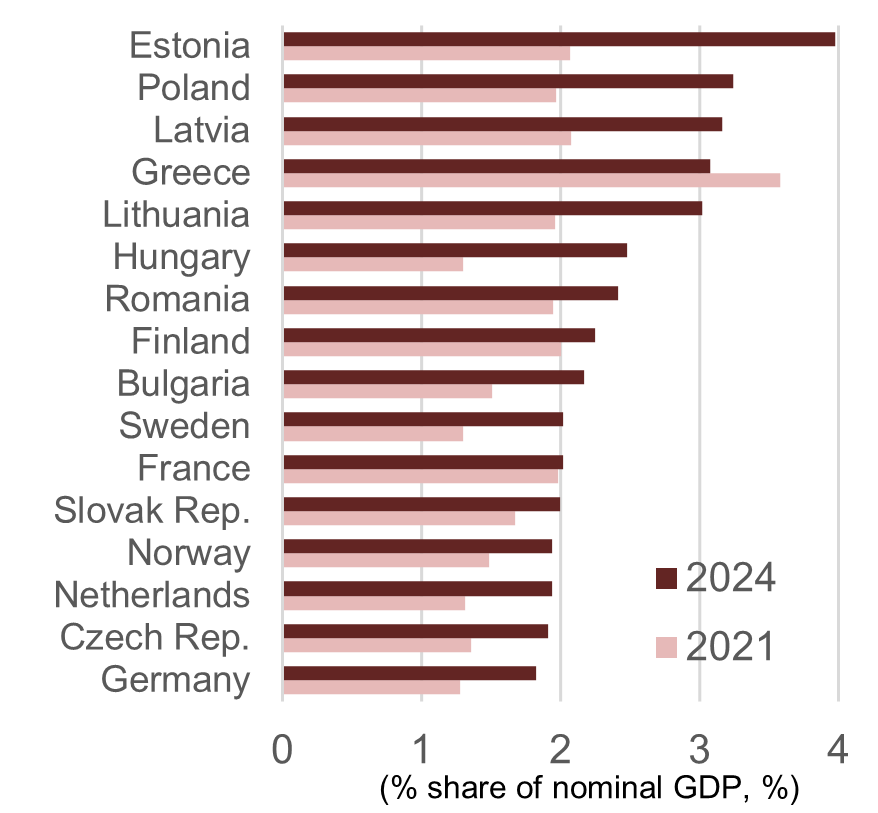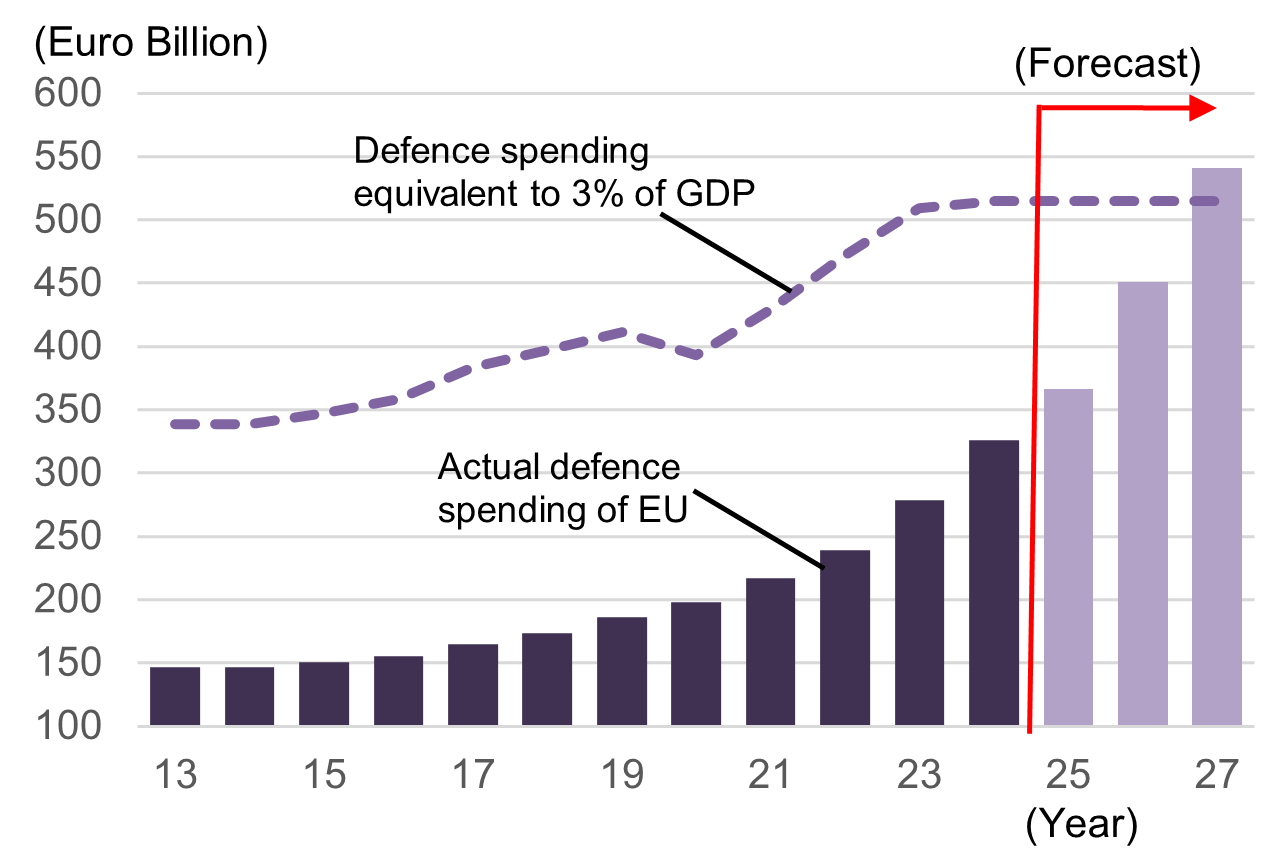~ The 800 billion euro increase in defence spending will boost the EU economy, with Germany expanding defence and infrastructure investments ~
Apr. 28, 2025
The EU is accelerating the strengthening of its defence capabilities. In March, the European Commission announced the White Paper on European Defence and the ReArm Europe Plan, which aims to expand defence investment totaling 800 billion euros (approximately 130 trillion yen). At the EU Summit held on March 6 and March 20-21, a broad agreement was reached among EU leaders on both proposals. The key feature of the EU's new defence strengthening policy is that under the concept of "strategic autonomy," it aims to enhance defence capabilities while simultaneously strengthening the competitiveness of the defence industry within the region.
Since Russia's invasion of Ukraine in February 2022, the security environment in Europe has changed significantly. Two weeks after the outbreak of the war, the EU issued the Versailles Declaration, outlining its intention to bolster defence capabilities by 2030, reduce external energy dependencies, and build a more robust industrial base. In March 2024, the EU unveiled the European Defence Industrial Strategy (EDIS), taking further steps to concretely strengthen the defence industry.
The re-election of President Trump in November 2024 accelerated this trend. With his return, the "EU-NATO system," which had been in place since the Cold War—where the EU pursued economic integration and growth separately from defence strengthening under the security of the U.S.-led NATO—was forced into a decisive shift.
A unique issue for the EU in strengthening its defence capabilities and industrial base was the need to secure funding while maintaining fiscal discipline. In the EU, the framework for maintaining fiscal discipline, which had been suspended since 2020 due to the COVID-19 pandemic, resumed in 2023. In countries such as Central and Eastern Europe and the Baltic states, the challenge of balancing increasing military expenditures with fiscal discipline became more difficult (Figure 1).

Figure 1: Defence spending of EU countries
On March 4, the European Commission announced the "ReArm Europe Plan," a financial support plan aimed at enhancing the EU's defence capabilities. The EU aims to increase defence spending by a total of 800 billion euros over four years, through higher expenditures by member states and financing from the EU.
The ReArm Europe Plan consists mainly of the following three points. The first is the expansion of national defence budgets. To achieve this, the EU has decided to exclude defence spending up to 1.5% of GDP from the Stability and Growth Pact (SGP), which is the rule for fiscal discipline. As a result, an increase of 650 billion euros in defence spending is expected from the 800 billion euros mentioned above.
The second is the creation of an EU loan framework for expanding national defence investments. Of the 800 billion euros, the remaining 150 billion euros will be allocated to this initiative. The EU will issue EU bonds to raise funds from the market. The loans will be provided on the condition that defence investments are made through joint public procurement within the EU.
The third is the utilization of the EU's mid-term budget. Specifically, in the next EU Multiannual Financial Framework (mid-term budget) for the period 2028-2034, approximately 400 billion euros from the Cohesion Fund, which is allocated for regional subsidies, is expected to be directed towards defence investments. However, as discussions on the next mid-term budget will begin in mid-2025, the framework for this allocation will be discussed in the future.
Considering that the recovery fund "NextGenerationEU" had a financial scale of 750 billion euros, the 800 billion euros allocated for the ReArm Europe Plan is substantial. However, out of the 800 billion euros in funding, 650 billion euros will come from national fiscal expenditures by each member state, and only 150 billion euros will come from EU-level funding. Therefore, there are concerns about whether coordinated military expansion at the EU level is feasible.
The strengthening of defence capabilities in the EU and Germany is expected to boost the EU economy. Under the ReArm Europe Plan, defence spending up to 1.5% of GDP has been excluded from the Stability and Growth Pact. Considering that the ReArm Europe Plan has a scale of 800 billion euros (approximately 4.5% of GDP) over four years, a gradual increase in defence spending of about 1% to 1.5% of GDP per year is assumed to be the target level for the EU. This would correspond to an increase in defence spending of about 180 to 270 billion euros annually. As a result, EU defence spending is expected to rise to 3.0% to 3.5% of GDP (Figure 2).
However, the EU imports a significant amount of weapons from outside the region, including the U.S. From June 2022 to June 2023, approximately 75 billion euros of defence spending by EU member states, 78% of which was procured from outside the EU, with 63% of the procurement coming from the U.S. The estimated fiscal multiplier of the increase in defence spending on GDP is around 0.5. Based on this estimate, the GDP boost effect would be around 90 to 135 billion euros, or approximately 0.6% of GDP. Assuming a gradual increase in defence spending, it is expected that between 2026 and 2027, the annual GDP growth rate will be boosted by about 0.3 percentage points.

Figure 2: Trends and outlook of defence spending in the EU27 countries
In response to the EU's actions, Germany, the largest economy in Europe, has amended its constitution (Basic Law) to remove the debt ceiling for defence spending and has decided to expand infrastructure investment by 500 billion euros over 12 years. In the general elections on February 23, 2025, the Christian Democratic Union/Christian Social Union (CDU/CSU), which had been in opposition, became the largest party. Coalition talks are underway to form a government with the Social Democratic Party (SPD).
Since 2009, Germany has adhered to a strict fiscal discipline rule known as the "debt brake," which limits government borrowing to less than 0.35% of GDP under the Basic Law. However, CDU's incoming Chancellor Merz shifted towards relaxing the debt brake clause due to the necessity of expanding defence spending and reached an agreement with the SPD, the coalition partner. The proposed amendment to the Basic Law, gaining support from the Greens, passed both chambers of parliament on March 21 and was enacted, resulting in the removal of the debt ceiling for defence spending.
The key points of the Basic Law amendment are as shown in Table 1. Among them, expenditures exceeding 1% of GDP in the defence expenditure will be excluded from the application of the debt brake, and the establishment of a special infrastructure fund totaling 500 billion euros (approximately 11.6% of GDP) over 12 years is a central component. The infrastructure special fund will be used for investments in areas such as security, transportation, hospitals, energy, education, science, R&D, and digitalization. Additionally, due to the Green Party's demands, 100 billion euros will be allocated to achieving climate change goals.
The German government's shift towards expanding infrastructure investments through medium-term fiscal expansion marks a significant policy change. While it is necessary to assess the negative impact of Trump's tariffs, it is worth noting that, alongside strengthening national defence, this could serve as a catalyst for the revival of German economy, which has recently been labeled the 'sick man of Europe.'
|
|
|

Kenichiro Yoshida
Chief Researcher, Global Intelligence and Research Office, Hitachi Research Institute
Engaged in research on economic and financial conditions in the United States and Europe. After graduating from Hitotsubashi University's Faculty of Commerce, he worked at Mizuho Research Institute and served as the Chief Representative of Mizuho Research Institute's London Office before assuming his current position in 2021.
Author’s Introduction

Kenichiro Yoshida
Chief Researcher
Global Intelligence and Research Office
We provide you with the latest information on HRI‘s periodicals, such as our journal and economic forecasts, as well as reports, interviews, columns, and other information based on our research activities.
Hitachi Research Institute welcomes questions, consultations, and inquiries related to articles published in the "Hitachi Souken" Journal through our contact form.